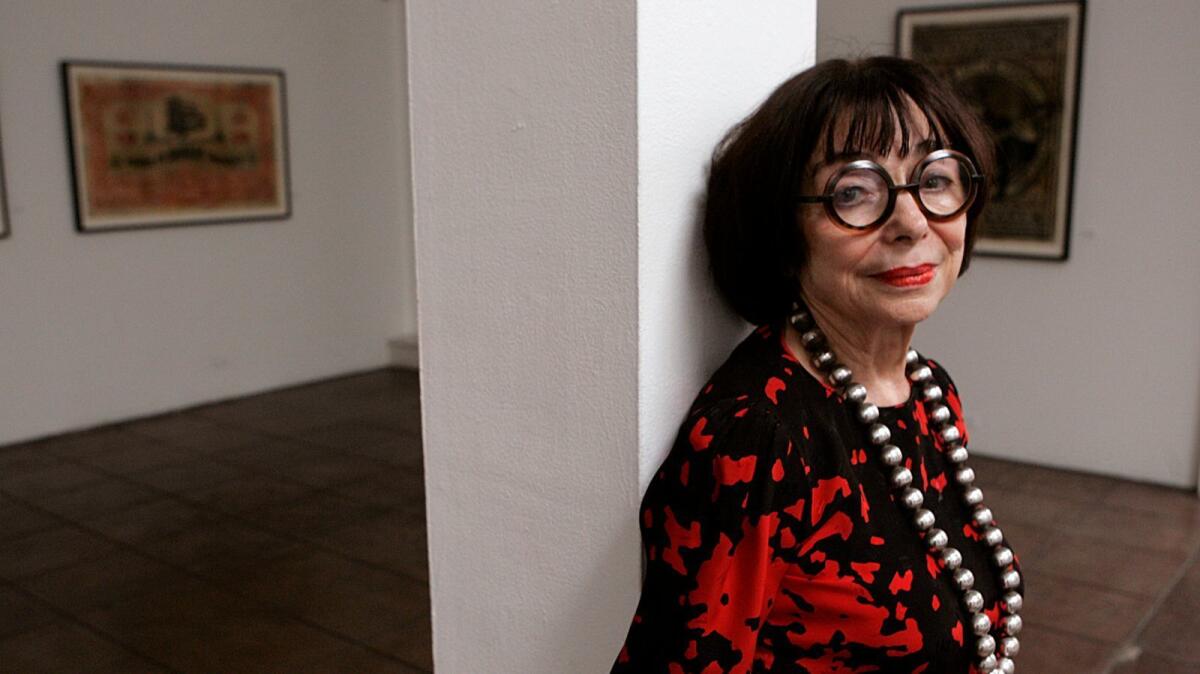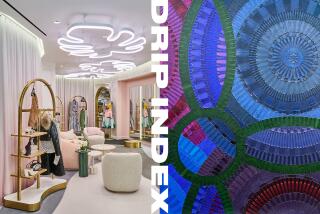Jan Baum, art dealer who pioneered La Brea’s gallery row in the 1980s, dies at 89

Jan Baum, a dealer who presented key Los Angeles artists such as Chris Burden and Betye Saar and helped establish La Brea Avenue as a gallery hub in the 1980s, has died at 89.
Her death, on Christmas Day following a cerebral edema, was confirmed by her husband of 66 years, Dr. Richard Baum.
Peter Plagens, an artist and critic whom Baum represented for years, described her as “a steady rudder for the L.A. art world.”
“Jan Baum was very good because she was art for art’s sake,” he said from New York City, where he lives. “She didn’t care that much about selling. Obviously she sold because it was a business. But she wasn’t about pushing. And she was always amenable, pleasant to deal with and cheery.”
Baum operated two galleries in her lifetime: Baum-Silverman Gallery on Santa Monica Boulevard in West Hollywood, and later the Jan Baum Gallery at 170 S. La Brea Ave.
The first gallery was a partnership with Iris Silverman, a private dealer in African and Oceanic art. The pair launched the space in 1977 with an unusual mix of ethnographic African art and contemporary work by American artists.
During its three years, Baum-Silverman exhibited work by important artists including Saar, who had a solo exhibition there during the first year. A review by The Times’ Suzanne Muchnic described the show’s “originality, constancy and depth” as “reassuring.”
Saar, a pioneering member of the Black Arts Movement, showed with Baum until the late 1990s. She described an open-minded gallerist who was willing to tackle a range of work, materials and ideas.
“She was open to women artists, to the political thing too,” Saar said. “She had the knack to mix contemporary art with ethnic art and it felt right.… It was very open and friendly — like showing your work with friends.”
She also recalled the petite, personable gallerist’s presence. “I close my eyes and I see her black hair and her red lipstick,” Saar said. “Plus, she was my size. And when you’re a short person, there’s nothing like a person you can look in the eyes.”
In that space, Baum also showed a wry installation by Burden titled “Full Financial Disclosure” that was composed of a year’s worth of the artist’s canceled personal checks. The piece, wrote Burden, was “in keeping with the Bicentennial spirit, the post-Watergate mood and the new atmosphere on Capitol Hill.”
In 1980, Silverman died and Baum struck out on her own.
Jan Baum Gallery opened the following year in a two-story Art Deco building on La Brea near 2nd Street — an area that wasn’t exactly known as a budding gallery district. Howard Fox, then a curator of contemporary at the Los Angeles County Museum of Art, told The Times in 2007 that it was a surprising location: “I remember thinking La Brea was nothing but used-car places and vacuum cleaner repair shops.”
But the gallery nonetheless proved to be a success. Within five years, more than a dozen other galleries had opened up shop in the area, including Kirsten Kiser and Fahey/Klein (the latter of which remains in business).
Baum stayed for 26 years, showing work by Saar, as well as painters such as Jim Morphesis and Mel Ruben. She also presented exhibitions by Saar’s daughters, Alison Saar and Lezley Saar. She told The Times upon her retirement in 2007 that she liked to show whatever “grabs my heart.”
Plagens said Baum was the rare dealer willing to take on a painter who was also a critic.
“I had a foot on both sides of the street, so it was hard to get a dealer,” he said. “A lot of dealers didn’t want to show me because people were like, ‘They’re only showing him because he writes for Artforum.’ Or, ‘He mouths off too much about other artists and that can’t be good.’”
Baum, he said, didn’t care. “She was supportive and enthusiastic.”
Jan Baum was born Janice Tobin in Newark, N.J., in 1928. She attended the University of Wisconsin intending to study medicine but switched to art after taking a course in art history. During her first year of school, she met Richard Baum, a young pre-med student who would become her husband in 1951
“She was very cute and she was very bright,” he recalled, “and I knew she would go places.”
The couple moved to Los Angeles in 1952, where they raised three children: Rick, Halli and Betsy.
The gallery business started as a bit of a lark. Baum had been working as a docent at LACMA when her friend Silverman approached her about opening a gallery together. The next morning, they found an empty storefront on Santa Monica Boulevard — wedged right between the prominent art spaces operated by Nicholas Wilder and James Corcoran.
“We walked to the closest pay phone and tied up the property,” she told The Times in 2007. Within 22 hours of conceiving the idea, they had a gallery.
“Had I had more time and given it more more consideration and thought, I may not have done this,” she said. “But it was destiny.”
Sign up for our weekly Essential Arts & Culture newsletter »
ALSO
Clifford Irving, author of notorious Howard Hughes literary hoax, dies at 87
Review: In these two art shows, the political is personal for our post-Women’s March country
More to Read
The biggest entertainment stories
Get our big stories about Hollywood, film, television, music, arts, culture and more right in your inbox as soon as they publish.
You may occasionally receive promotional content from the Los Angeles Times.











